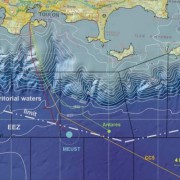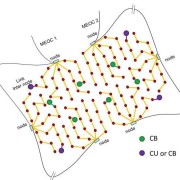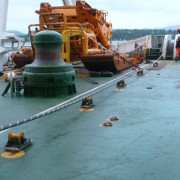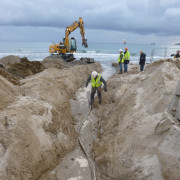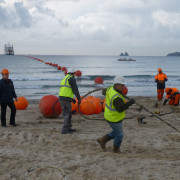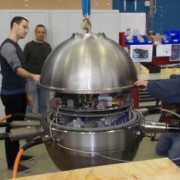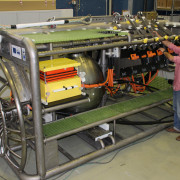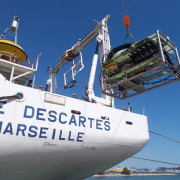The KM3NeT-Fr infrastructure
Since 2023 the infrastructure of KM3NeT-Fr is part of the Laboratoire Sous-marin Provence Mèditerraneé (LSPM). The KM3NeT-Fr site is located at the Mediterranean coast south of Toulon, France.
Location
The KM3NeT-Fr deep sea installation site is located at 42°48’ N 06°02’ E about 40 km off-shore Toulon, France. It is located at a depth of about 2450 m and about 10 km west of the ANTARES neutrino telescope – the predecessor of KM3NeT. The control station first located at the Institute Michel Pacha at La Seyne sur Mer, now moved to Laboratoire Sous-marin Provence Mèditerraneé (LSPM). The location of both the former ANTARES telescope and the new KM3NeT-Fr site are visible in the picture of the map of the Mediterranean south of Toulon France.
Seabed Infrastructure
A high-speed electro-optical network is installed on the seabed to provide power and data transmission to/from the infrastructure. The infrastructure is connected to shore via two main electro-optic cables (MEOCs). Each MEOC supplies three nodes and each node hosts eight user ports. In the baseline design, four KM3NeT detection units are daisy chained together and at least five chains are connected to each node. On each node a single user port can host earth and sea science instrumentation. The KM3NeT-Fr site will host the ORCA detector for particle physics.
Onshore facilities
The two MEOCs are connected to a power station at the Les Sablettes beach of La Seyne sur Mer. From there a land cable runs to the shore-station, first located at the Institut Michel Pacha, now moved to the Ifremer campus Laboratoire Sous-marin Provence Mèditerraneé (LSPM) at La Seyne sur Mer. In the control station dedicated software running on a PC farm filters the data and applies a first selection and event reconstruction. The selected data are transmitted via a 10 GB/s link to the KM3NeT data repository at the computing centre in Lyon.
First phase of implementation
The first phase of the KM3NeT-Fr seabed infrastructure comprised a single main electro-optic cable to shore, one node, six KM3NeT/ORCA-style detection units and a single line hosting a variety of oceanographic sensors
In December 2014, the main electro-optical cable was deployed. In 2017, a redesign of the cable by Arcatel appeared to be necessary to adjust to the fact that at KM3NeT-Fr AC-power is used in stead of DC-power. End of 2018, the new cable was installed.
In April 2015, the first node of the KM3NeT-Fr deep-sea network was connected to the deep-sea end of the main cable. The node has sufficient sockets to connect at least 20 detection units, of which six were indeed installed during the first phase of construction of KM3NeT. In 2018, the node was re-installed at the deep-sea end of the new cable to shore.
KM3NeT-Fr 2.0
The next step in the implementation of the KM3NeT-Fr deep-sea infrastructure has started. At the end of this phase the seabed network with be completed with up to six nodes for connection of the 115 detection units of the ORCA neutrino detector of KM3NeT for the determination of the relative ordering of the neutrino masses, also referred to as neutrino mass hierarchy. Currently, 28 detection units are installed. The full implementation of the KM3NeT-Fr 2.0 deep-sea infrastructure is partially funded.

